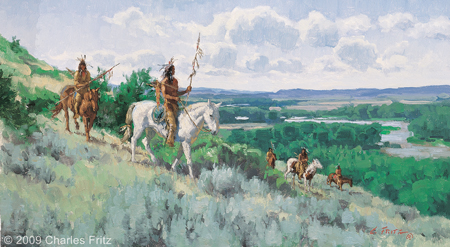At Clark’s Yellowstone canoe camp near present Laurel, Montana, the group wakes to find several horses are missing—likely stolen by Crow Indians. Pvt. Gibson‘s wound is healing and one dugout canoe is nearly ready.
On the Marias River, Lewis and his small group turn up Cut Bank Creek hoping it’s source is above the 50th parallel. With no trees present, they make a fire from buffalo dung.
Above the Great Falls of the Missouri, Sgts. Gass and Ordway delay the portage while a search is made for missing horses. They are plagued by mosquitoes and gnats.[1]For more on the captains’ strategy and various groups after leaving Travelers’ Rest, see Dividing Forces at Travelers’ Rest.
Camp Disappointment
by Yellowstone Public Radio[2]Originally aired weekdays by Yellowstone Public Radio during the Bicentennial observance of 2003-2006. Narrated by Hal Hansen. Scripts by Whit Hansen and Ed Jacobson. Produced by Leni Holliman. © … Continue reading
Absaroka Scouts, Elk River
10″ x 18″ oil on board
© 2009 by Charles Fritz. Used by permission.
Clark’s Stolen Horses
Searching for Horses
This morning I was informed that Half of our horses were absent. Sent out Shannon Bratten [Bratton], and Shabono [Charbonneau] to hunt them . . . . I am apprehensive that the indians have Stolen our horses, and probably those who had made the Smoke a fiew days passed towards the S. W.
—William Clark
Gibson Doing Better
Gibsons wound is beginning to heal. I am in great hope that it will get well in time for him to accompany Sgt. Pryor with the horses to the Mandans.
—William Clark
One Canoe Nearly Ready
the men work very diligiently on the Canoes one of them nearly finished ready to put in the water.
—William Clark
Buffalo Attended by Wolves
the plains are butifull and leavel but the Soil is but thin Stoney and in maney parts of the plains & bottoms there are great quantity of prickly pears. . . . . The wolves which are the constant attendants of the Buffalow are in great numbers on the Scerts of those large gangues which are to be Seen in every direction in those praries
—William Clark
Weather Diary (Clark)
State of the weather at Sun rise Wind at Sun rise State of the weather at 4 P. M Wind at 4 P M. fair N E cloudy N. E. river falls a little and the water is nearly Clear
—William Clark[3]To assist the reader of this web page, the date column is omitted and some abbreviations have been spelled out.
Lewis Turns Up Cut Bank Creek
Cut Bank Creek
© 27 June 2013 by Kristopher K. Townsend. Permission to use granted under the Creative Commons Attribution-Share Alike 4.0 International license.
Missing the Ford
the pack horse which carried my instruments missed the ford and wet the instruments. this accident detained us about half an hor. I took the Instruments out wiped them and dryed their cases, they sustained no naterial injury.
—Meriwether Lewis
Cut Bank Creek
we struck a northern branch of Marias river about 30 yds. wide at the distance of about 8 miles from it’s entrance. this stream is closely confined between clifts of freestone rocks the bottom narrow below us and above the rocks confine it on each side;
—Meriwether Lewis
Cut Bank Camp
after dinner we set out up the North branch keeping on it’s S. side; we pursued it untill dark and not finding any timber halted and made a fire of the dung of the buffaloe. we lay on the south side in a narrow bottom under a Clift. our provision is nearly out, we wounded a buffaloe this evening but could not get him.
—Meriwether Lewis
Weather Diary (Lewis)
State of the weather at rise
Wind at rise
State of the weather at 4 P. M. Wind at 4 P. M. fair N. fair N. E. —Meriwether Lewis
Gass and Ordway’s Horses Disappear
Missing Horses
One of the men went out for the horses; and the rest of us put two canoes on the waggons, and moved them forward by hand some distance . . . . we lay where the canoes were all night.
—Patrick Gass
Smoking the Insects
concluded to delay tomorrow for our horses before we give them out. the Musquetoes and Small flyes verry troublesome we made fires of buffaloe dry dung to make Smoaks &c.
—John Ordway
Experience the Lewis and Clark Trail
The Lewis and Clark Trail Experience—our sister site at lewisandclark.travel—connects the world to people and places on the Lewis and Clark Trail.
Plan a trip related to July 21, 1806:
- Marias Museum of History and Art (Lewis)
- Billings, Montana (Clark)
- Three Forks to Billings Driving Tour (Clark)
- Lewis and Clark National Historic Trail Interpretive Center (Gass and Ordway)

Clark’s Canoe Camp on the Yellowstone is a High Potential Historic Site along the Lewis and Clark National Historic Trail managed by the U.S. National Park Service. The site is on private property.
The Great Falls Portage is a High Potential Historic Site along the Lewis and Clark National Historic Trail managed by the U.S. National Park Service. It includes Sulphur Springs (open to the public) and Lower Portage Camp site (private land), and the Upper Portage Camp Overlook.
Notes
| ↑1 | For more on the captains’ strategy and various groups after leaving Travelers’ Rest, see Dividing Forces at Travelers’ Rest. |
|---|---|
| ↑2 | Originally aired weekdays by Yellowstone Public Radio during the Bicentennial observance of 2003-2006. Narrated by Hal Hansen. Scripts by Whit Hansen and Ed Jacobson. Produced by Leni Holliman. © 2003 by Yellowstone Public Radio. |
| ↑3 | To assist the reader of this web page, the date column is omitted and some abbreviations have been spelled out. |




